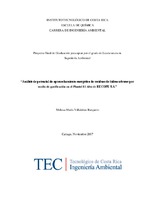Mostrar el registro sencillo del ítem
Análisis de potencial de aprovechamiento energético de residuos de hidrocarburos por medio de gasificación en el Plantel El Alto de RECOPE S.A.
| dc.contributor.author | Villalobos-Barquero, Melissa María | |
| dc.date.accessioned | 2018-02-08T16:20:30Z | |
| dc.date.available | 2018-02-08T16:20:30Z | |
| dc.date.issued | 2017 | |
| dc.identifier.uri | https://hdl.handle.net/2238/9362 | |
| dc.description | Proyecto de Graduación (Licenciatura en Ingeniería Ambiental) Instituto Tecnológico de Costa Rica, Escuela de Química, 2017. | es |
| dc.description.abstract | As a result of the operations performed at Plantel El Alto of the Refinadora Costarricense de Petróleo Sociedad Anónima (RECOPE S.A.), wastes are being generated, which mostly come from hydrocarbons. Those that are present in most quantities are sludge from hydrocarbon storage tanks and a type of mixtures formed by fuels, water and solids, which are known as slop. Between the 2012 – 2016 period, the approximate annual average aproduction of these wastes at Plantel El Alto was 55.66 metric tons and 25.38 metric tons respectively. In order to provide them an adequate disposal, the wastes are sent to Geocycle, which is a company in charge of their final treatment, but this implies to the refinery an associated cost of $430 per metric ton of waste. Some of these wastes have important energy contents, which is why they were submitted to an analysis of energy potential to use them in a gasification process, with the purpose of a future energy production at Plantel El Alto. Gasification is a technique that has been widely used for the treatment of waste from refineries and has the advantage that it is flexible with respect to the quality of the raw material used. Sampling of four different types of hydrocarbon residues identified as A, B, C and D was carried out. Residues A, B and D are sludge from storage tanks and residue C is a mixture of oil spills and contaminated materials known as black product. There were determined water and sediment content, moisture content, calorific value, the thermal behavior analyzed by thermogravimetric analysis and differential scanning calorimetry, ash content, density and viscosity. The results obtained were analyzed taking into consideration all the factors necessary to obtain an adequate performance in a gasification process. Of the residues studied, A and C have densities very similar to that of diesel, a very low water and sediment content as well as a very low moisture content and high calorific values, corresponding to the residues that present the greatest potential of energy use, which can be used as raw material in a gasification system. The residues B and D present high moisture contents, so a pretreatment is recommended to separate the water from the hydrocarbon fraction in order to obtain raw materials suitable to be used for energy purposes. | es |
| dc.description.sponsorship | Plantel El Alto de RECOPE S.A. | es |
| dc.language.iso | spa | es |
| dc.publisher | Instituto Tecnológico de Costa Rica | es |
| dc.rights | acceso abierto | es |
| dc.subject | Residuos | es |
| dc.subject | Hidrocarburos | es |
| dc.subject | Gasificación | es |
| dc.subject | Humedad | es |
| dc.subject | Combustibles | es |
| dc.subject | Research Subject Categories::NATURAL SCIENCES::Chemistry::Environmental chemistry::Environmental toxicology | es |
| dc.title | Análisis de potencial de aprovechamiento energético de residuos de hidrocarburos por medio de gasificación en el Plantel El Alto de RECOPE S.A. | es |
| dc.type | proyecto fin de carrera | es |


